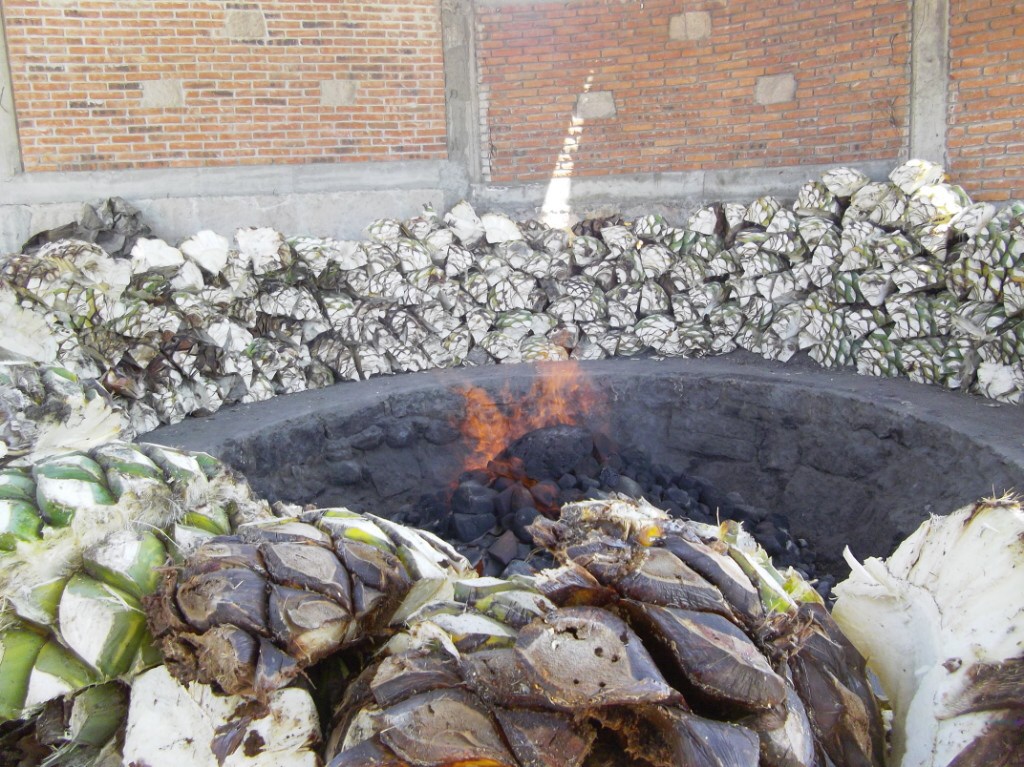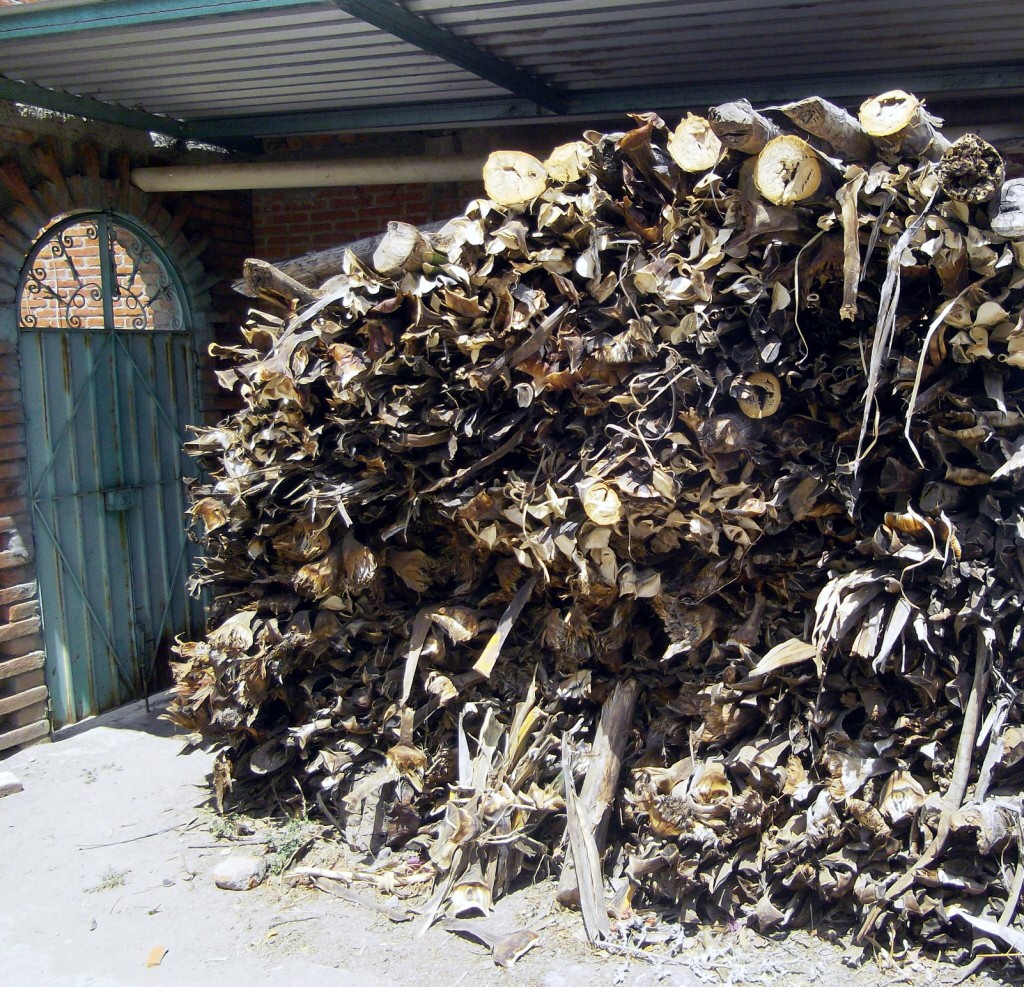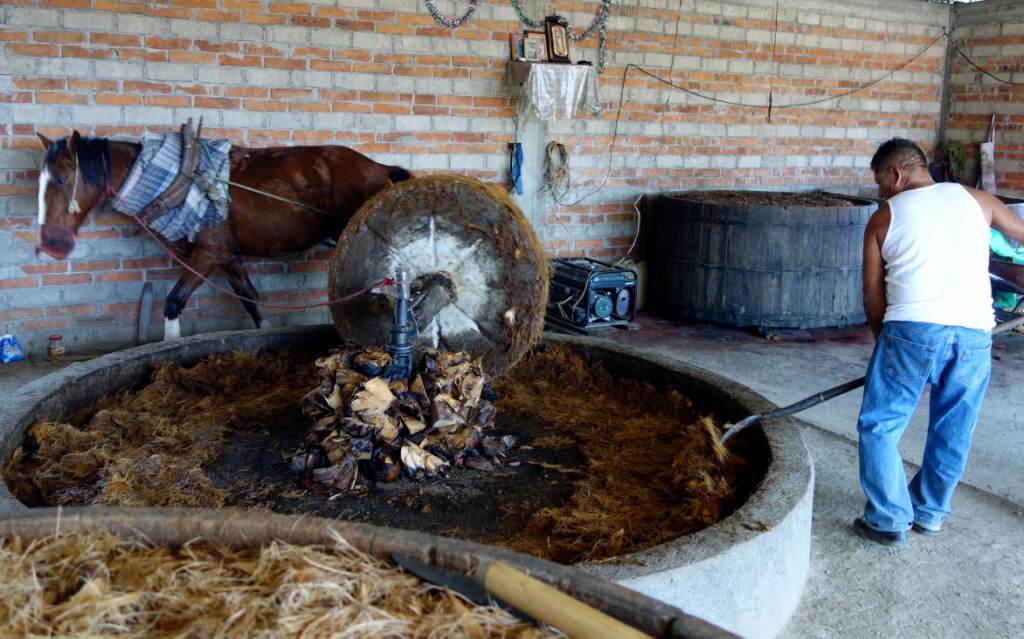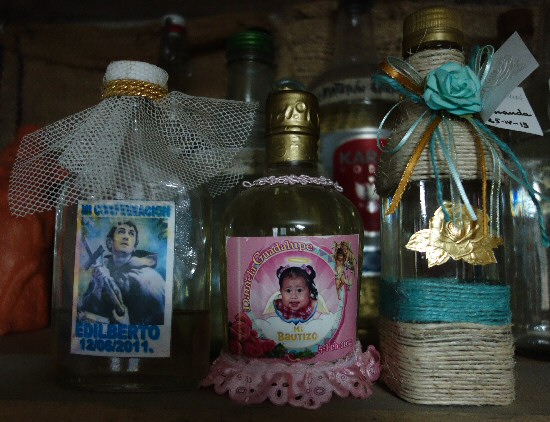
Mezcal bottles
|
 Mezcal bottles
|
Hand-crafted mezcal production follows roughly the following regimen, summarized in the briefest of terms:
Typically the palenquero and his family have been making mezcal all their lives based on recipes passed down through generations. While production is of course based on scientific principles, for them it's a learned skill, as opposed to reliance upon sophisticated instruments and equipment.
Mezcal Production as Sustainable and Environmentally Friendly
While agave takes a long time to grow, once small starter plants have been transplanted from a home environment or greenhouse into the field in rows about a meter apart, if the planting occurs during the rainy season no irrigation is required pending maturity and harvesting. Other crops can be planted in between the rows, enabling farmers to reap from their fields while the agave is maturing. Depending on the specie, agave can be reproduced in two or three ways, with a single plant capable of producing thousands of offspring through germinating seeds.
Mezcal made with wild agave is often coveted and fetches a high price. Yes, there is a concern that in a couple of decades none will be left. To address the issue, some brand owners embark upon an annual program whereby they plant small agave in the hills and leave them to mature. Some communities only permit their residents to harvest wild agave from communal land if the palenquero agrees to plant two small agave for every mature one harvested.
Though annual weeding may be preferred in fields under cultivation, it is certainly not necessary. Although infestations are infrequent, if the problem is the larvae known as "the worm" [gusano], even it can be harvested for multiple uses; to make worm salt often used as a mezcal chaser, to put in a bottle of mezcal as a marketing tool or to change the spirit's flavor, and for cooking including use as a key salsa ingredient. Gusanos dried and sometimes salted are also eaten as a snack.
The mere existence of the pre-Hispanic goddess of agave (some believe of also fertility), Mayahuel, is testament to the important of the succulent dating back millennia. For at least 2,000 years some species have been used to produce pulque, a fermented beverage said to have multiple medicinal properties. These types of agave can also be used to make mezcal.
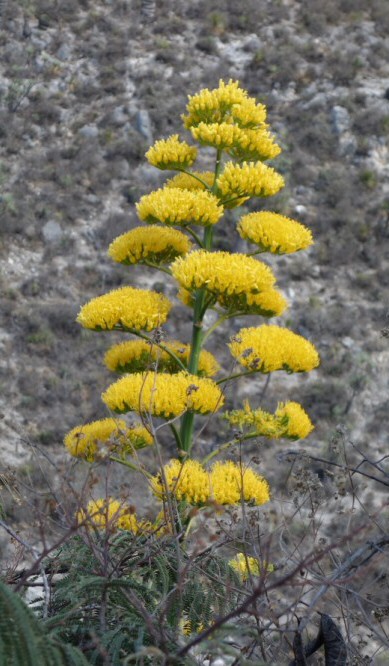 Agave bloom
|
But the unused parts of the plant continue to play a crucial role in the lives of many Mexicans. When piñas are harvested to be transformed into mezcal, the leaves are typically left in the field, and are harvested once they begin to dry. Residents of nearby villages use them as firewood to fuel pottery kilns and for cooking a broad array of foodstuffs. The tall flower stalk [quiote] which shoots up at maturity is also used for firewood, in addition to being employed as a building material, and even to make a didgeridoo-like musical instrument. The fibrous leaves are used to make rope, clothing, grain sacks, horse bridles, and more, even sewing thread.
Once the first distillation has been completed, remaining water and fiber are emptied from the still. While that water is at times used for irrigating (yes, this has been deemed to have a negative environment impact) and producing distilled water for use in reducing mezcal to the desired ABV, the fiber [bagazo] also has innumerable uses. It is utilized 1) to insulate the rocks from the piñas in the baking process, 2) as compost, 3) as mulch for growing agave, tomatoes and other crops, 4) to make adobe bricks, 5) to make paper, 6) as the substratum for commercially growing mushrooms, 7) to make small planters which can then be placed directly into the ground when the plant's roots get too large, 8) as fire starter, and more.
While the argument has been made that diesel is a much cleaner fuel than firewood for cooking agave and distilling, it is noteworthy that for baking agave, "seconds" in the forestry industry can be used to fuel the oven. The "waste" from debarking logs in lumber yards is often used to heat stills since typically there is some wood with the shavings from the logs.
After baking, the logs which were at the base of the oven have become charred wood. It is typically broken into small pieces, put into grain sacks, and sold as charcoal for cooking. Palenqueros also use it as fertilizer, in particular for growing starter agave. They also use ash from their stills as fertilizer.
Copper is expensive, and in fact buying a 300 liter still costs in the range of 70,000 pesos. But you can get 25+ years out of it, and when parts become corroded the still can often be repaired. If the still is clay, locally produced pots are typically employed. In both instances, the stills are encased often using a mix of mud, sand, adobe, block and clay bricks, with a bit of cement. With copper alembics a small length of rubber hose often serves as the spigot, and with clay pot distillation it's usually a length of river reed [carrizo]. In both cases a length of carrizo is also typically used as a venencia to test ABV, and as a fief to extract samples of the fermenting liquid from the bottom of the tina.
A plethora of items which might otherwise be discarded or at minimum stored away until sometime in the distant future, find use in the mezcal industry, including 1) oil drums and aluminum hard hats for condensing, 2) tire rims and old wooden boards in still construction, 3) irreparably damaged washing machines, sterilized petroleum drums, a natural (or excavated) ground depression fermenting, 4) cured 20 liter plastic cooking oil receptacles and glass bottles from four liter cheap California wine for storing and transporting. And the list goes on.
More out of economic necessity and ingenuity than by design, those in the business of distilling mezcal have over generations created what we now should consider an extremely sustainable and environmentally friendly industry. Nothing goes to waste.
No Two Batches of Artisanal Mezcal Are The Same
Often subsistence farmers sell their agave to palenqueros. They can't wait a decade to turn their land into money, so frequently, as noted earlier, they plant other crops such as corn, beans and squash in between the rows of the succulent. Each crop impacts the soil differently, which impacts agave growth, which impacts the ultimate flavor of the mezcal. So if the producer makes mezcal from agave grown by one farmer one month, and from another the next month, the two batches will be different; and often the palenquero doesn't know what crop has been impacting the agave over what period of time in what way. And, if he harvests from one side of a mountain one time, and from the other the next, even assuming there are no crops impacting growth, the end result will vary; sunshine, temperature and precipitation are different on each side of the slope and affect growth in fluctuating ways over that decade or so.
If you bake anything in a sealed chamber over firewood for several days, the type of log employed will impact the quality of what you're cooking, as will temperature. Palenqueros typically prefer hardwood over softer logs such as pine, but even assuming the former, not all the tree trunks used are always from the same type of tree; oak, mesquite, eucalyptus and others, are all used. It often varies from batch to batch. And although even and consistent baking of all piñas is the preference, it rarely if ever happens. Some are cooked less, and others more and in fact almost charred to the point where they are unusable. The extent of baking impacts the flavor of the sugary rich agave hearts.
Not all fermentation vessels are created equally. Type of vat impacts mezcal flavor. While most in Oaxaca use wooden vats which last several years, palenqueros are continually buying new ones and discarding the old, often made of varying types of wood. Some of the most dramatic changes in nuance result from the type of receptacle in which the agave is fermented. For example some palenqueros still ferment in a cow skin hung from a rafter, and in Michoacán often fermentation occurs in an oak lined pit below ground.
Artisanal mezcal production typically relies on well or mountain spring water added to the tinas filled with the sweet baked crushed agave. Both sources of water have varying compounds depending on the time of year, which ultimately alters each batch of mezcal based on water quality. Similarly, true open air fermentation relies on invisible yeasts which float around the environment. They change from season to season (and in theory day to day). Thus, if all else remains the same in terms of the piñas, means of production and tools of the trade, a batch of mezcal distilled today must inevitably be different from the batch to be made in six months because the yeasts causing fermentation are different.
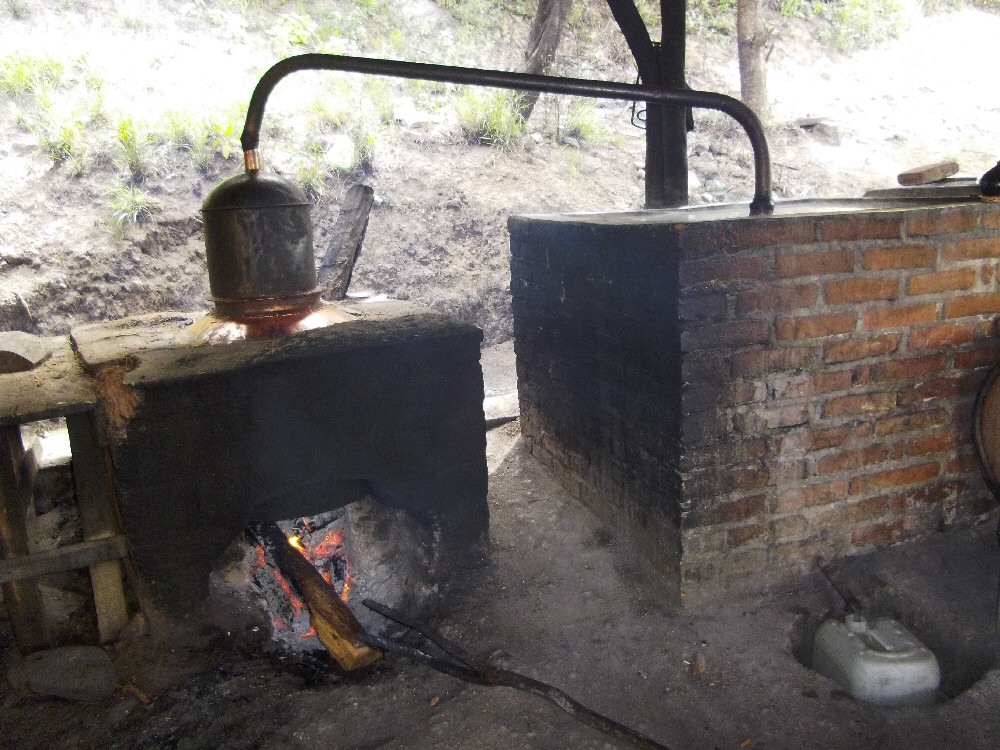 Mezcal distillation
|
A master palenqero aims to make every batch of mezcal as best he can, not the same as the last, recognizing that such a task is near impossible if not indeed so.
The Cultural and Economic Significance of Mezcal in Oaxaca
Agave spirits date back, depending on the theory to which one subscribes, to between over 450 and as much as about 2500 years ago. And Oaxaca is the state in which as much as 85% of Mexico's mezcal is distilled. As noted earlier, traditionally mezcal was a spirit for the masses, in predominantly rural Oaxaca. Middle class urbanites shunned the spirit, and drank mainly beer, dark rum (i.e. Bacardi Solera), whisky (i.e. Johnny Walker red label over ice and soda water), even tequila, and more recently cocktails and wine. In the villages back then (and incidentally still today), because of its extremely modest price relative to other alcohols, mezcal was served at virtually every rite of passage event, from baptisms to funerals and everything in between. A couple of drops for mother earth before imbibing remains an important part of rural practice.
My own contemporary experience with culturally based rural imbibing dates back only 26 years; at least that's as far back as I can remember. Back then, (and in fact continuing today) the importance of mezcal was such that it was often distributed in sealed bottles as party favors at weddings, quince años, baptisms and first communions---complete with labels noting the event, and often including a photo of the child or couple; or with a representation of Jesus.
Leap forward to about 1995, when Mezcal del Maguey began exporting to the US and then further abroad. The middle classes in Mexico City started to catch on. Then those of substantial means in Oaxaca finally began to exhibit a sense of pride in mezcal. Tequila, rum and whisky began to be replaced with mezcal, even at the most posh of affairs. It is now commonplace to find a hand blown glass bottle gracing every table at a middle class wedding, filled with the host's favorite mezcal made by his preferred artisanal palenquero.
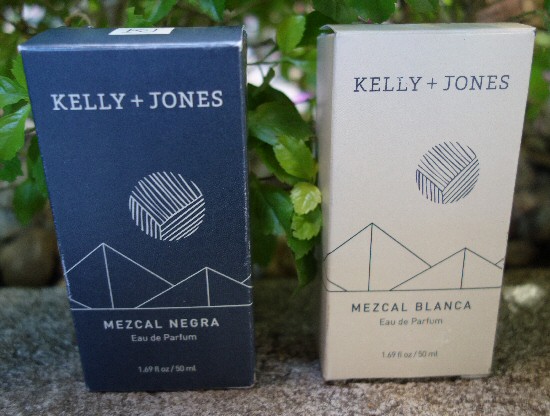 Mezcal perfume
|
The second decade of the century has borne witness to the birth of mezcal tourism. People from across the globe are now making a pilgrimage to Oaxaca to learn about their new preferred spirit and to visit the artisanal factory of their favorite brand. Entrepreneurs are flocking to the city for advice about opening mezcalerías in their hometowns, and to investigate exporting the spirit to the US, Canada, Germany, Central and South America, Australia, South Africa, and elsewhere. Authors are writing treatises about mezcal for the lay populace and spirits aficionados, and social anthropologists are feverishly working on dissertations and book deals financed by academic publishing houses. Bacardi and Pernod Ricard have jumped on the bandwagon, with other multinational alcohol producers and distributors following suit. The spinoffs from the foregoing are significant, providing more than simply direct benefit for the state in terms of industries such as hospitality and restaurant. With mezcal sales exploding, consider the benefits for bottle and top manufacturers and printing houses for labels and promotional materials. It seems as though almost every retail outlet in the state sells at least something relative to mezcal or agave: carved wooden figures [alebrijes] with bar scenes, textile designs featuring the majestic agave succulent, t-shirts, shot glasses, pottery vessels, agave earrings, etc., etc., etc. And I alone have commissioned baseball caps, market bags, oven mitts, and full color mezcal tasting wheels noting over 200 aromas and flavors. A New York perfume manufacturer (Kelly + Jones) has recently begun marketing two fragrances of mezcal perfume. Imagine!
Mezcal has become a driving force, not only for Oaxaca and Mexico more generally, but with global impact. Whether you imbibe or not, one must appreciate the sustainability and environmental protection within the artisanal mezcal industry. And for those who do, the batch to batch variability.
Alvin Starkman operates Mezcal Educational Excursions of Oaxaca (www.mezcaleducationaltours.com).
